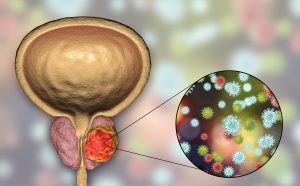Uro-oncologists believe prostate cancer is more of an urban disease with Bengaluru, Delhi and Pune showing an increase in such cases.

Representational image of a man suffering from pain during urination. Increase in frequency to urinate, difficulty in peeing and blood in urine are some symptoms of Prostate Cancer. (Creative Commons)
Bank manager Deepesh Jain, 54, did not take the issue seriously at first. But as it persisted, he decided to consult a doctor.
“My only symptom was that I had to rush to the bathroom more often during the day. Whenever I went, my bladder won’t fully empty and I had to strain to empty it”, he presented the problem.
The urologist prescribed an immediate scan, which revealed a tumour in Jain’s prostrate — a walnut-sized — gland that forms part of the male reproductive system. After further investigation, Jain was diagnosed with cancer.
Jain is among hundreds of men who do not recognise the symptoms of urinary tract cancers — prostate cancers — which keep rising every year, especially among the urban populace.
At the recently held SOGOCON-2022, several uro-oncologists spoke about how prostate cancers have risen to become the second most common cancer in urban populations, especially in cities such as Bengaluru, Pune, Delhi. Till a few years ago, prostate cancer was in fourth place.
“In contrast to other cancers, prostate cancer is unique. It is more common in urban populations than rural, and its incidence among people living in cities is further increasing”, Dr Raghunath SK of the HCG Cancer Hospital in Bengaluru, told South First.
Dr Raghunath was also the organising secretary of SOGOCON 2022, the first-ever annual conference of the Society of Genitourinary Oncologists (SOGO).
Lifestyle, food habits, stress, pollution, lack of exercise, working late hours and exposure to chemicals are some of the possible reasons for an increase in prostate cancers, he said. Late diagnosis, he added, would worsen the situation.
Besides lifestyle, age and family history could also add to the risk of prostate cancers. The risk, oncologists said, would go up if a person has more than one first-degree relative i.e., father, son, or brother, with prostate cancer, including relatives in three generations on either side of your parents’ family.
Prostate cancer has been termed a ‘silent disease’ since the majority of cases would have minimal or no symptoms.
Speaking to South First, Dr Govardhan Reddy, Lead Consultant, Urology and Uro Oncology, Aster CMI Hospital in Bengaluru, detailed three symptoms one should watch out for: Increased frequency in the urge to urinate, difficulty in passing urine, burning sensation, pain, and blood in the urine.
Difficulty in achieving an erection or painful ejaculation, too, could be symptoms of prostate cancer. If the urine contains blood or the person experiences decreased energy levels with weight loss, a visit to a urologist is a must.
Could prostate cancer be detected in advance? Dr Govardhan recommended regular check-ups for men above 45.
“A routine screening of all men aged above 45 years, which can include Digital Rectal Examination (DRE), and if needed, Serum PSA levels is recommended”, the doctor advised.
“Screening is a must from the age of 40 itself for men with a family history of any cancer, especially with a history of prostate cancer,” he added.
Speaking to South First, Dr Srivatsa Narasimha, Consultant Uro-oncologist at the Sri Shankara Cancer Hospital and Research Centre in Bengaluru said besides being genetically driven, more than 90 percent of prostate cancer “shows an array of mutations, causing the disease to progress”.

Conceptual image for viral ethiology of prostate cancer. 3D illustration showing viruses infecting prostate gland which develops cancerous tumor (Wikimedia Commons)
“They are also heterogeneous. Clusters of genetic variations are possible in the same prostate gland. A biopsy of the gland which is the current standard method to evaluate these changes may miss a more serious mutate that could actually be the driver of disease progression”, he pointed out.
Dr Srivatsa highlighted the importance of a pan-gland evaluation of genetic architecture of the disease.
Meanwhile, oncologists said that prostate cancer-related mortality is high in India compared to other countries. And it could be avoided.
“Sixty-five percent of all patients detected with prostate cancer die in India, while in countries like Australia and the US it is only 12%. The major reason is that we detect prostate cancer at the very last stage due to lack of awareness”, Dr Raghunath said.
Agreeing, renowned oncologist and chairman of SOGOCON 2022, Dr Shekar Patil said, “We can reduce mortality and morbidity if the government partners with hospitals to create awareness and promote early detection through regular health screening.”
Dr Govardhan further explained the multiple advanced treatment options available in India for prostate cancers, robotic surgery, and radiation facilities amongst other things.
“The challenge is to make it affordable and if the state governments can include it under their respective health insurance schemes, it can save several lives,” Dr Shekar added.

Jul 09, 2024

Jul 03, 2024

Jul 03, 2024

Jun 28, 2024

Jun 28, 2024

Jun 26, 2024